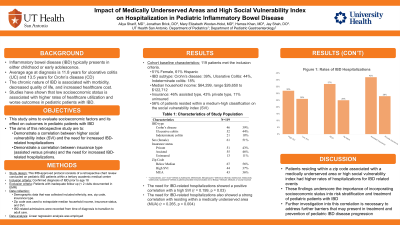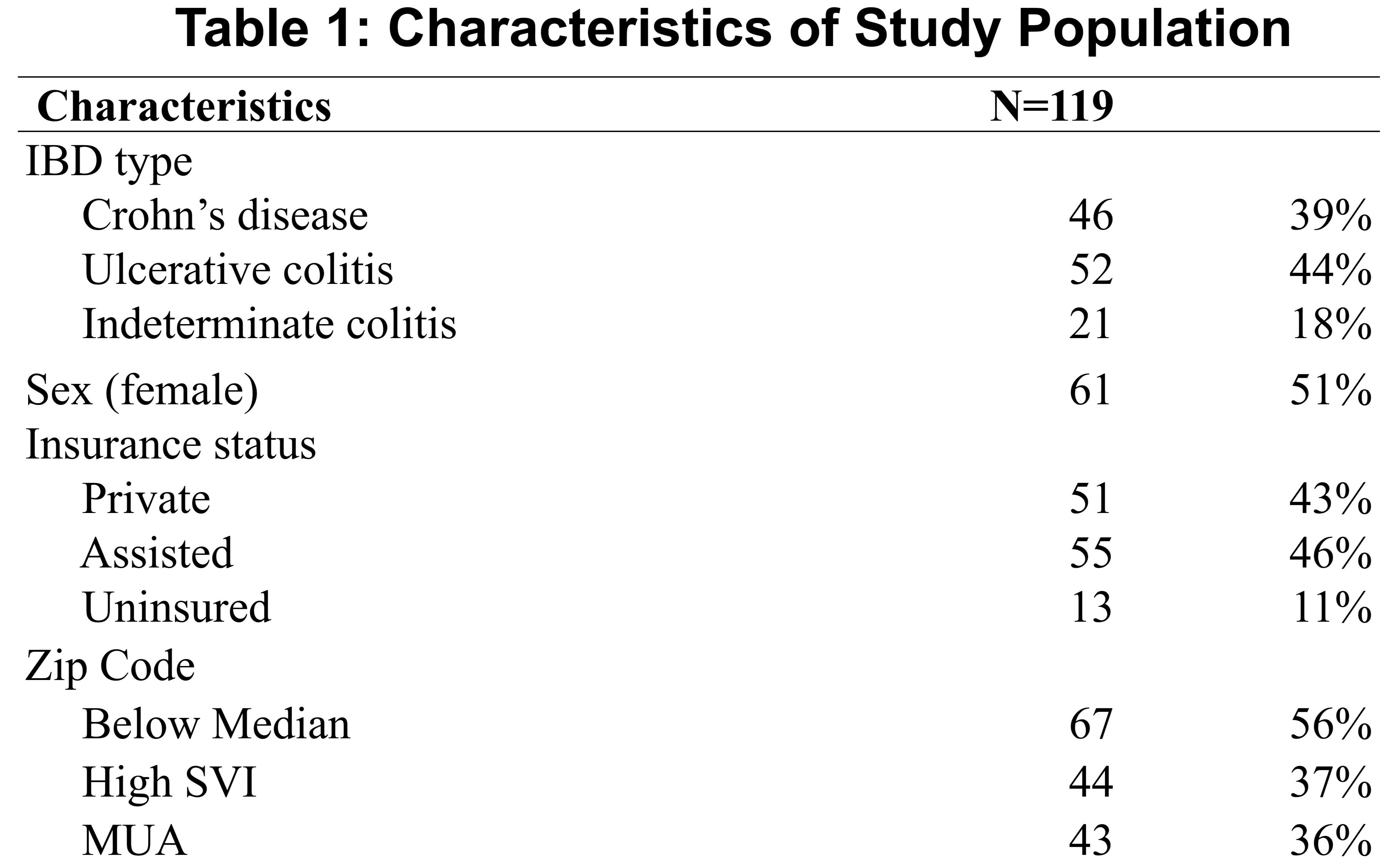Sunday Poster Session
Category: Pediatrics
P1182 - Impact of Medically Underserved Areas and High Social Vulnerability Index on Hospitalization in Pediatric Inflammatory Bowel Disease
Sunday, October 22, 2023
3:30 PM - 7:00 PM PT
Location: Exhibit Hall

Has Audio
- AS
Aliya Sharif, MD
UT Health San Antonio
San Antonio, Texas
Presenting Author(s)
Aliya Sharif, MD1, Jonathan Brick, DO2, Mary Elizabeth Wootan-Holst, MD2, Hamza Khan, MD1, Jay Shah, DO2
1UT Health San Antonio, San Antonio, TX; 2University of Texas Health Science Center at San Antonio, San Antonio, TX
Introduction: Inflammatory bowel disease (IBD) typically presents in either childhood or early adolescence. The chronic nature of IBD is associated with morbidity, decreased quality of life, and increased healthcare cost. Studies have shown that low socioeconomic status is associated with higher rates of healthcare utilization and worse outcomes in pediatric patients with IBD. This study aims to evaluate socioeconomic factors and its effect on outcomes in pediatric patients with IBD.
Methods: A retrospective chart review was conducted on pediatric patients with IBD who were followed at an outpatient clinic within a large tertiary academic medical center. Inclusion criteria included confirmed diagnosis of IBD prior to age 18. Patients with inadequate follow up were excluded from this study. Demographic data was collected to include zip code which was used to extrapolate the following socioeconomic factors: median household income, insurance status, medically underserved areas (MUA), and social vulnerability index (SVI). IBD related admissions and prescriptions were recorded from the time of diagnosis until transition to adult care. Linear regression analysis was employed for data analysis.
Results: A total of 119 patients were included in this study (51% female, 61% Hispanic). The breakdown of IBD subtypes was as follows: 44% UC, 39% CD, and 18% indeterminate colitis. The median household income by zip code averaged $64,299, ranging from $26,650 to $122,712. Among the participants, 46% had assisted insurance, 43% had private insurance, and 11% were uninsured. Of the participants, 36% (N=43) resided within a medically underserved area, and 10% (N=12) were considered part of a medically underserved population. Additionally, 56% of the patients resided within a zip code classified as medium-high on the SVI. The need for IBD-related hospitalizations showed a positive correlation with a high SVI (r = 0.199, p = 0.03) while residing within an MUA exhibited a strong correlation (r = 0.265, p = 0.004).
Discussion: Patients who resided within a zip code associated with an MUA or high SVI had higher rates of hospitalizations for IBD related events. These findings underscore the significance of incorporating socioeconomic status into the risk stratification and treatment of pediatric patients with IBD. Further investigation into this correlation is necessary to help address socioeconomic barriers that may present in treatment and prevention of pediatric IBD disease progression.

Disclosures:
Aliya Sharif, MD1, Jonathan Brick, DO2, Mary Elizabeth Wootan-Holst, MD2, Hamza Khan, MD1, Jay Shah, DO2. P1182 - Impact of Medically Underserved Areas and High Social Vulnerability Index on Hospitalization in Pediatric Inflammatory Bowel Disease, ACG 2023 Annual Scientific Meeting Abstracts. Vancouver, BC, Canada: American College of Gastroenterology.
1UT Health San Antonio, San Antonio, TX; 2University of Texas Health Science Center at San Antonio, San Antonio, TX
Introduction: Inflammatory bowel disease (IBD) typically presents in either childhood or early adolescence. The chronic nature of IBD is associated with morbidity, decreased quality of life, and increased healthcare cost. Studies have shown that low socioeconomic status is associated with higher rates of healthcare utilization and worse outcomes in pediatric patients with IBD. This study aims to evaluate socioeconomic factors and its effect on outcomes in pediatric patients with IBD.
Methods: A retrospective chart review was conducted on pediatric patients with IBD who were followed at an outpatient clinic within a large tertiary academic medical center. Inclusion criteria included confirmed diagnosis of IBD prior to age 18. Patients with inadequate follow up were excluded from this study. Demographic data was collected to include zip code which was used to extrapolate the following socioeconomic factors: median household income, insurance status, medically underserved areas (MUA), and social vulnerability index (SVI). IBD related admissions and prescriptions were recorded from the time of diagnosis until transition to adult care. Linear regression analysis was employed for data analysis.
Results: A total of 119 patients were included in this study (51% female, 61% Hispanic). The breakdown of IBD subtypes was as follows: 44% UC, 39% CD, and 18% indeterminate colitis. The median household income by zip code averaged $64,299, ranging from $26,650 to $122,712. Among the participants, 46% had assisted insurance, 43% had private insurance, and 11% were uninsured. Of the participants, 36% (N=43) resided within a medically underserved area, and 10% (N=12) were considered part of a medically underserved population. Additionally, 56% of the patients resided within a zip code classified as medium-high on the SVI. The need for IBD-related hospitalizations showed a positive correlation with a high SVI (r = 0.199, p = 0.03) while residing within an MUA exhibited a strong correlation (r = 0.265, p = 0.004).
Discussion: Patients who resided within a zip code associated with an MUA or high SVI had higher rates of hospitalizations for IBD related events. These findings underscore the significance of incorporating socioeconomic status into the risk stratification and treatment of pediatric patients with IBD. Further investigation into this correlation is necessary to help address socioeconomic barriers that may present in treatment and prevention of pediatric IBD disease progression.

Figure: Table 1
Disclosures:
Aliya Sharif indicated no relevant financial relationships.
Jonathan Brick indicated no relevant financial relationships.
Mary Elizabeth Wootan-Holst indicated no relevant financial relationships.
Hamza Khan indicated no relevant financial relationships.
Jay Shah indicated no relevant financial relationships.
Aliya Sharif, MD1, Jonathan Brick, DO2, Mary Elizabeth Wootan-Holst, MD2, Hamza Khan, MD1, Jay Shah, DO2. P1182 - Impact of Medically Underserved Areas and High Social Vulnerability Index on Hospitalization in Pediatric Inflammatory Bowel Disease, ACG 2023 Annual Scientific Meeting Abstracts. Vancouver, BC, Canada: American College of Gastroenterology.
